GFTF Solicitors: Understanding Fixtures and Fittings in Property Law
VerifiedAdded on 2023/06/15
|10
|2689
|187
AI Summary
This article by GFTF Solicitors explains the concept of fixtures and fittings in property law. It covers the degree and purpose of annexation, and the law of Property Act 1925. The article uses case studies to illustrate the application of these concepts in real-life scenarios.
Contribute Materials
Your contribution can guide someone’s learning journey. Share your
documents today.
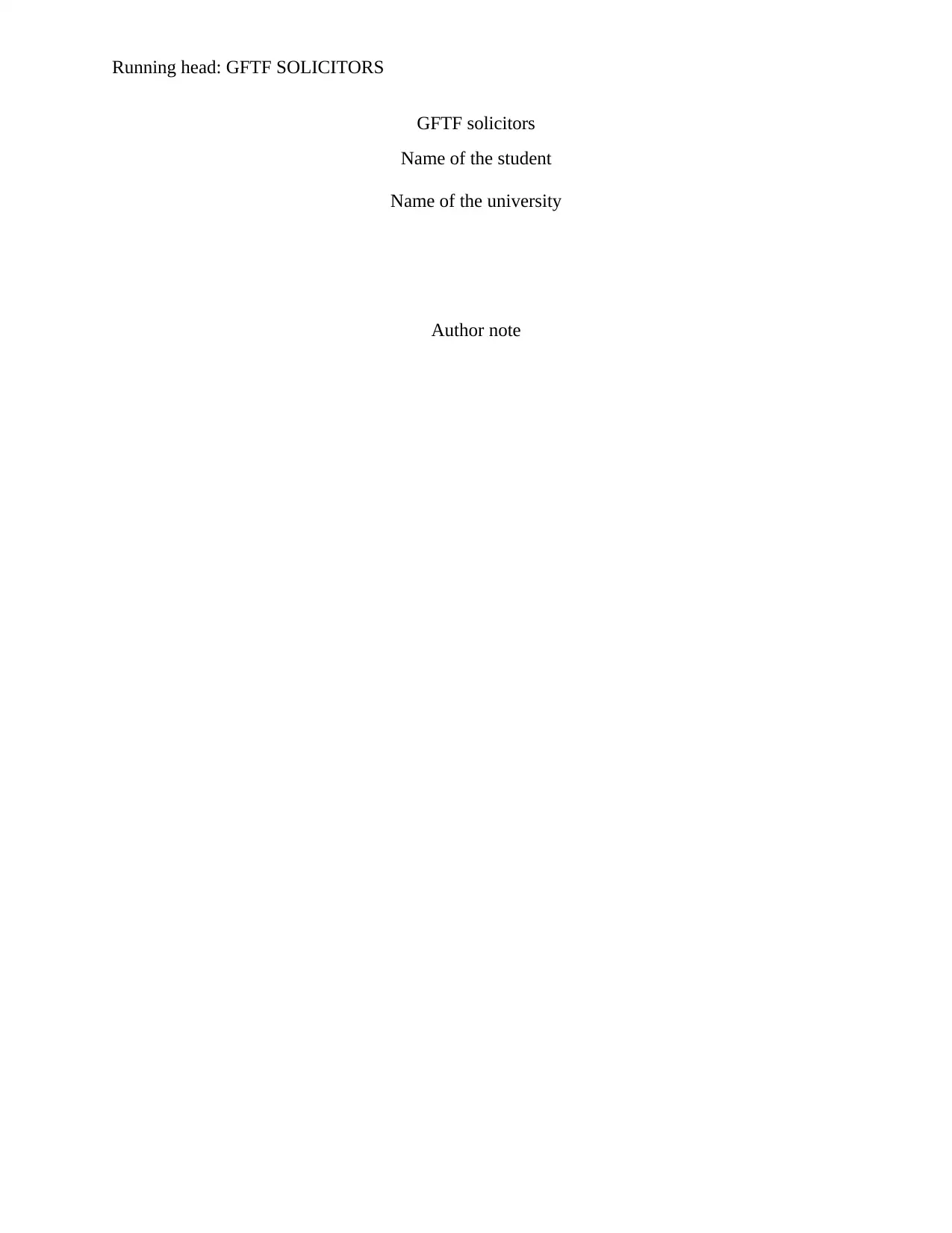
Running head: GFTF SOLICITORS
GFTF solicitors
Name of the student
Name of the university
Author note
GFTF solicitors
Name of the student
Name of the university
Author note
Secure Best Marks with AI Grader
Need help grading? Try our AI Grader for instant feedback on your assignments.

1
GFTF SOLICITORS
GFTF Solicitors
Kingston University
Surrey
Ms Amanda May
Gates Path
Cheam
Surrey
SM8 6NE
RE: WA0014536
Dear Ms Amanda May,
This letter is in response to the queries raised by you. As you are purchasing a freehold
detached house and believed that some of the items were part of the sale, the general law on
fixtures will be relevant, that is whatever is attached to the land belongs to the land which was
clearly outlined in Holland v Hodgson (1872).1 This will be beneficial to your case if indeed,
there were no agreements made, where it is specified what is excluded and what is exactly in the
sale.
1Holland v Hodgson (1872) LR 7 CP 328
GFTF SOLICITORS
GFTF Solicitors
Kingston University
Surrey
Ms Amanda May
Gates Path
Cheam
Surrey
SM8 6NE
RE: WA0014536
Dear Ms Amanda May,
This letter is in response to the queries raised by you. As you are purchasing a freehold
detached house and believed that some of the items were part of the sale, the general law on
fixtures will be relevant, that is whatever is attached to the land belongs to the land which was
clearly outlined in Holland v Hodgson (1872).1 This will be beneficial to your case if indeed,
there were no agreements made, where it is specified what is excluded and what is exactly in the
sale.
1Holland v Hodgson (1872) LR 7 CP 328
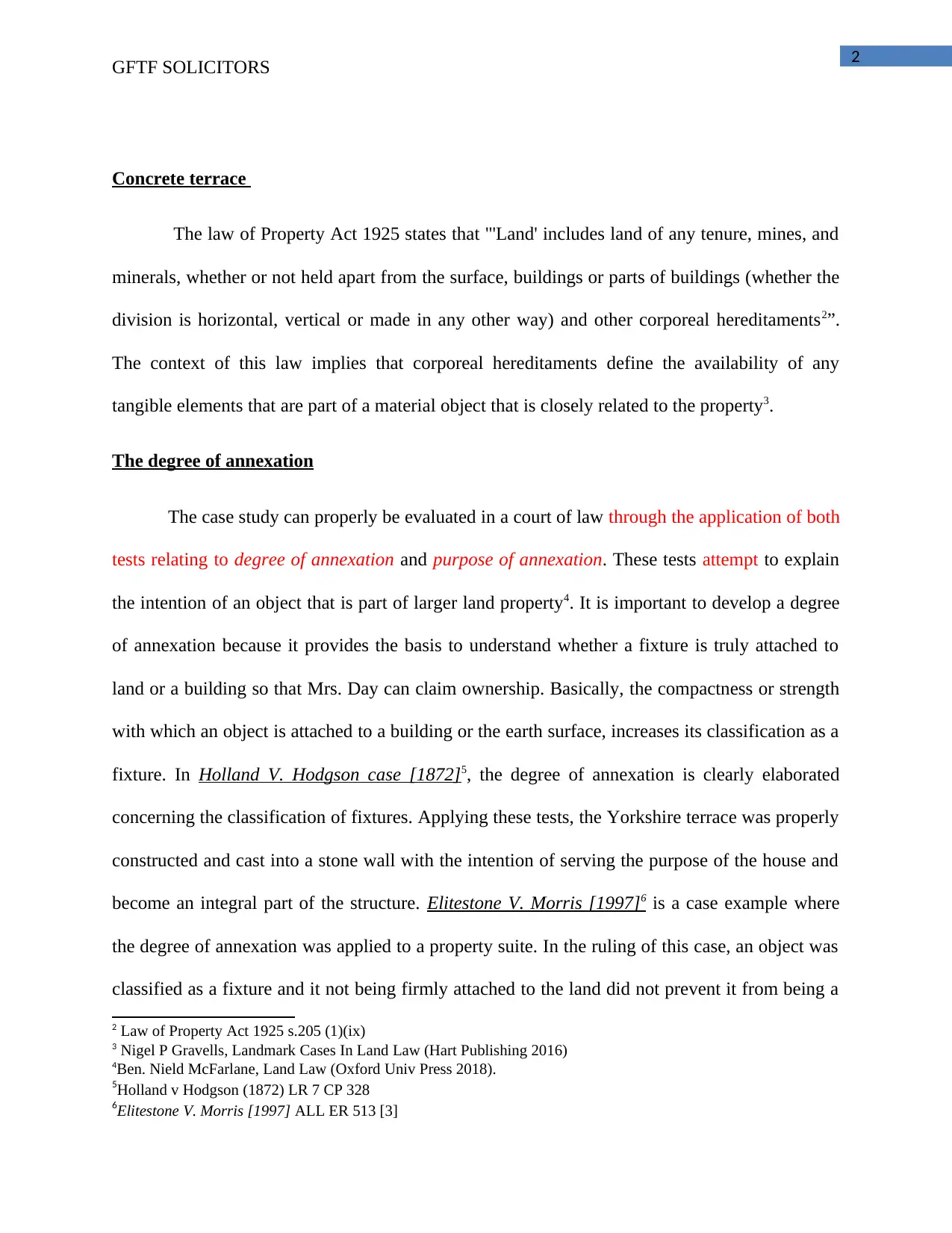
2
GFTF SOLICITORS
Concrete terrace
The law of Property Act 1925 states that "'Land' includes land of any tenure, mines, and
minerals, whether or not held apart from the surface, buildings or parts of buildings (whether the
division is horizontal, vertical or made in any other way) and other corporeal hereditaments2”.
The context of this law implies that corporeal hereditaments define the availability of any
tangible elements that are part of a material object that is closely related to the property3.
The degree of annexation
The case study can properly be evaluated in a court of law through the application of both
tests relating to degree of annexation and purpose of annexation. These tests attempt to explain
the intention of an object that is part of larger land property4. It is important to develop a degree
of annexation because it provides the basis to understand whether a fixture is truly attached to
land or a building so that Mrs. Day can claim ownership. Basically, the compactness or strength
with which an object is attached to a building or the earth surface, increases its classification as a
fixture. In Holland V. Hodgson case [1872]5, the degree of annexation is clearly elaborated
concerning the classification of fixtures. Applying these tests, the Yorkshire terrace was properly
constructed and cast into a stone wall with the intention of serving the purpose of the house and
become an integral part of the structure. Elitestone V. Morris [1997]6 is a case example where
the degree of annexation was applied to a property suite. In the ruling of this case, an object was
classified as a fixture and it not being firmly attached to the land did not prevent it from being a
2 Law of Property Act 1925 s.205 (1)(ix)
3 Nigel P Gravells, Landmark Cases In Land Law (Hart Publishing 2016)
4Ben. Nield McFarlane, Land Law (Oxford Univ Press 2018).
5Holland v Hodgson (1872) LR 7 CP 328
6Elitestone V. Morris [1997] ALL ER 513 [3]
GFTF SOLICITORS
Concrete terrace
The law of Property Act 1925 states that "'Land' includes land of any tenure, mines, and
minerals, whether or not held apart from the surface, buildings or parts of buildings (whether the
division is horizontal, vertical or made in any other way) and other corporeal hereditaments2”.
The context of this law implies that corporeal hereditaments define the availability of any
tangible elements that are part of a material object that is closely related to the property3.
The degree of annexation
The case study can properly be evaluated in a court of law through the application of both
tests relating to degree of annexation and purpose of annexation. These tests attempt to explain
the intention of an object that is part of larger land property4. It is important to develop a degree
of annexation because it provides the basis to understand whether a fixture is truly attached to
land or a building so that Mrs. Day can claim ownership. Basically, the compactness or strength
with which an object is attached to a building or the earth surface, increases its classification as a
fixture. In Holland V. Hodgson case [1872]5, the degree of annexation is clearly elaborated
concerning the classification of fixtures. Applying these tests, the Yorkshire terrace was properly
constructed and cast into a stone wall with the intention of serving the purpose of the house and
become an integral part of the structure. Elitestone V. Morris [1997]6 is a case example where
the degree of annexation was applied to a property suite. In the ruling of this case, an object was
classified as a fixture and it not being firmly attached to the land did not prevent it from being a
2 Law of Property Act 1925 s.205 (1)(ix)
3 Nigel P Gravells, Landmark Cases In Land Law (Hart Publishing 2016)
4Ben. Nield McFarlane, Land Law (Oxford Univ Press 2018).
5Holland v Hodgson (1872) LR 7 CP 328
6Elitestone V. Morris [1997] ALL ER 513 [3]
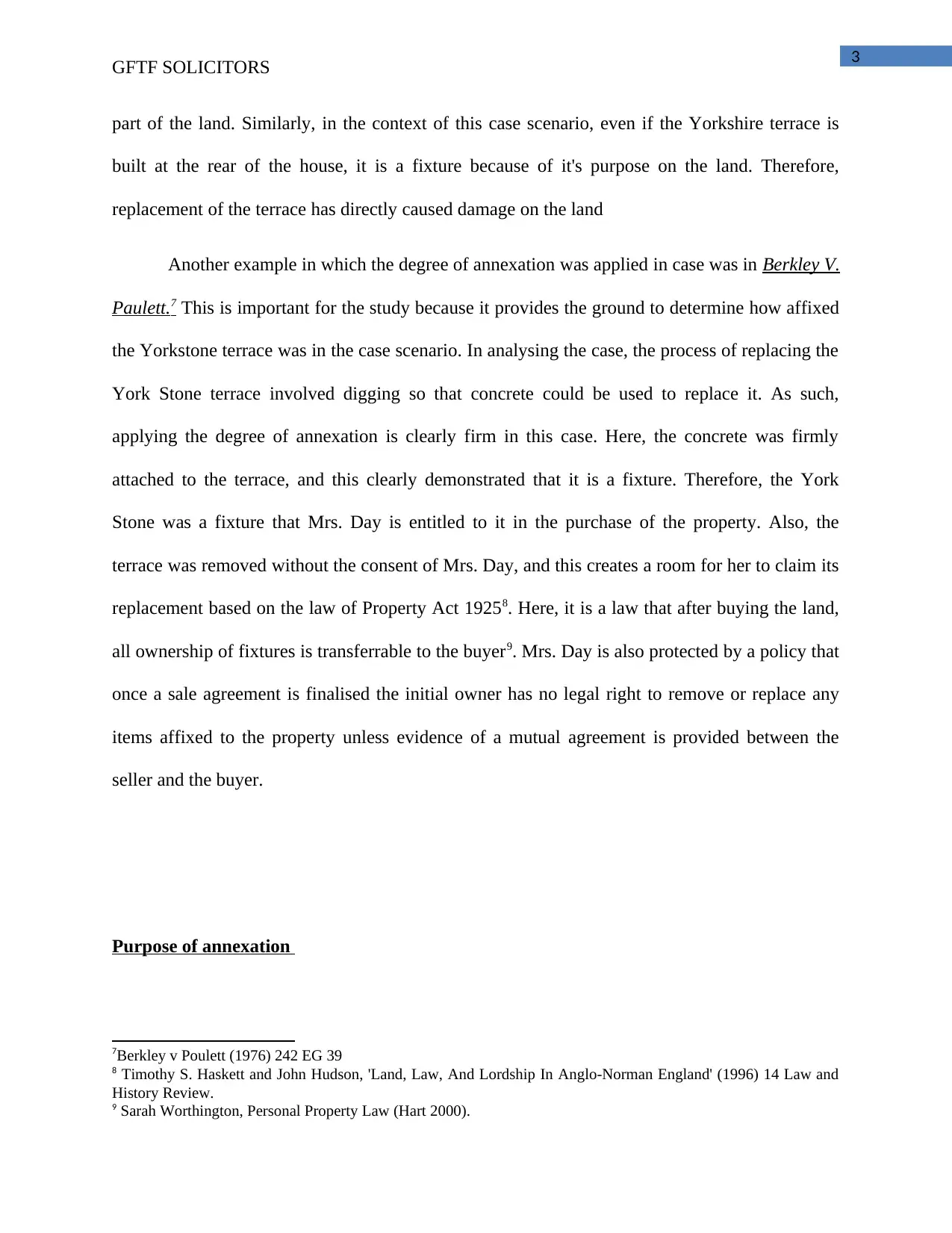
3
GFTF SOLICITORS
part of the land. Similarly, in the context of this case scenario, even if the Yorkshire terrace is
built at the rear of the house, it is a fixture because of it's purpose on the land. Therefore,
replacement of the terrace has directly caused damage on the land
Another example in which the degree of annexation was applied in case was in Berkley V.
Paulett.7 This is important for the study because it provides the ground to determine how affixed
the Yorkstone terrace was in the case scenario. In analysing the case, the process of replacing the
York Stone terrace involved digging so that concrete could be used to replace it. As such,
applying the degree of annexation is clearly firm in this case. Here, the concrete was firmly
attached to the terrace, and this clearly demonstrated that it is a fixture. Therefore, the York
Stone was a fixture that Mrs. Day is entitled to it in the purchase of the property. Also, the
terrace was removed without the consent of Mrs. Day, and this creates a room for her to claim its
replacement based on the law of Property Act 19258. Here, it is a law that after buying the land,
all ownership of fixtures is transferrable to the buyer9. Mrs. Day is also protected by a policy that
once a sale agreement is finalised the initial owner has no legal right to remove or replace any
items affixed to the property unless evidence of a mutual agreement is provided between the
seller and the buyer.
Purpose of annexation
7Berkley v Poulett (1976) 242 EG 39
8 Timothy S. Haskett and John Hudson, 'Land, Law, And Lordship In Anglo-Norman England' (1996) 14 Law and
History Review.
9 Sarah Worthington, Personal Property Law (Hart 2000).
GFTF SOLICITORS
part of the land. Similarly, in the context of this case scenario, even if the Yorkshire terrace is
built at the rear of the house, it is a fixture because of it's purpose on the land. Therefore,
replacement of the terrace has directly caused damage on the land
Another example in which the degree of annexation was applied in case was in Berkley V.
Paulett.7 This is important for the study because it provides the ground to determine how affixed
the Yorkstone terrace was in the case scenario. In analysing the case, the process of replacing the
York Stone terrace involved digging so that concrete could be used to replace it. As such,
applying the degree of annexation is clearly firm in this case. Here, the concrete was firmly
attached to the terrace, and this clearly demonstrated that it is a fixture. Therefore, the York
Stone was a fixture that Mrs. Day is entitled to it in the purchase of the property. Also, the
terrace was removed without the consent of Mrs. Day, and this creates a room for her to claim its
replacement based on the law of Property Act 19258. Here, it is a law that after buying the land,
all ownership of fixtures is transferrable to the buyer9. Mrs. Day is also protected by a policy that
once a sale agreement is finalised the initial owner has no legal right to remove or replace any
items affixed to the property unless evidence of a mutual agreement is provided between the
seller and the buyer.
Purpose of annexation
7Berkley v Poulett (1976) 242 EG 39
8 Timothy S. Haskett and John Hudson, 'Land, Law, And Lordship In Anglo-Norman England' (1996) 14 Law and
History Review.
9 Sarah Worthington, Personal Property Law (Hart 2000).
Secure Best Marks with AI Grader
Need help grading? Try our AI Grader for instant feedback on your assignments.
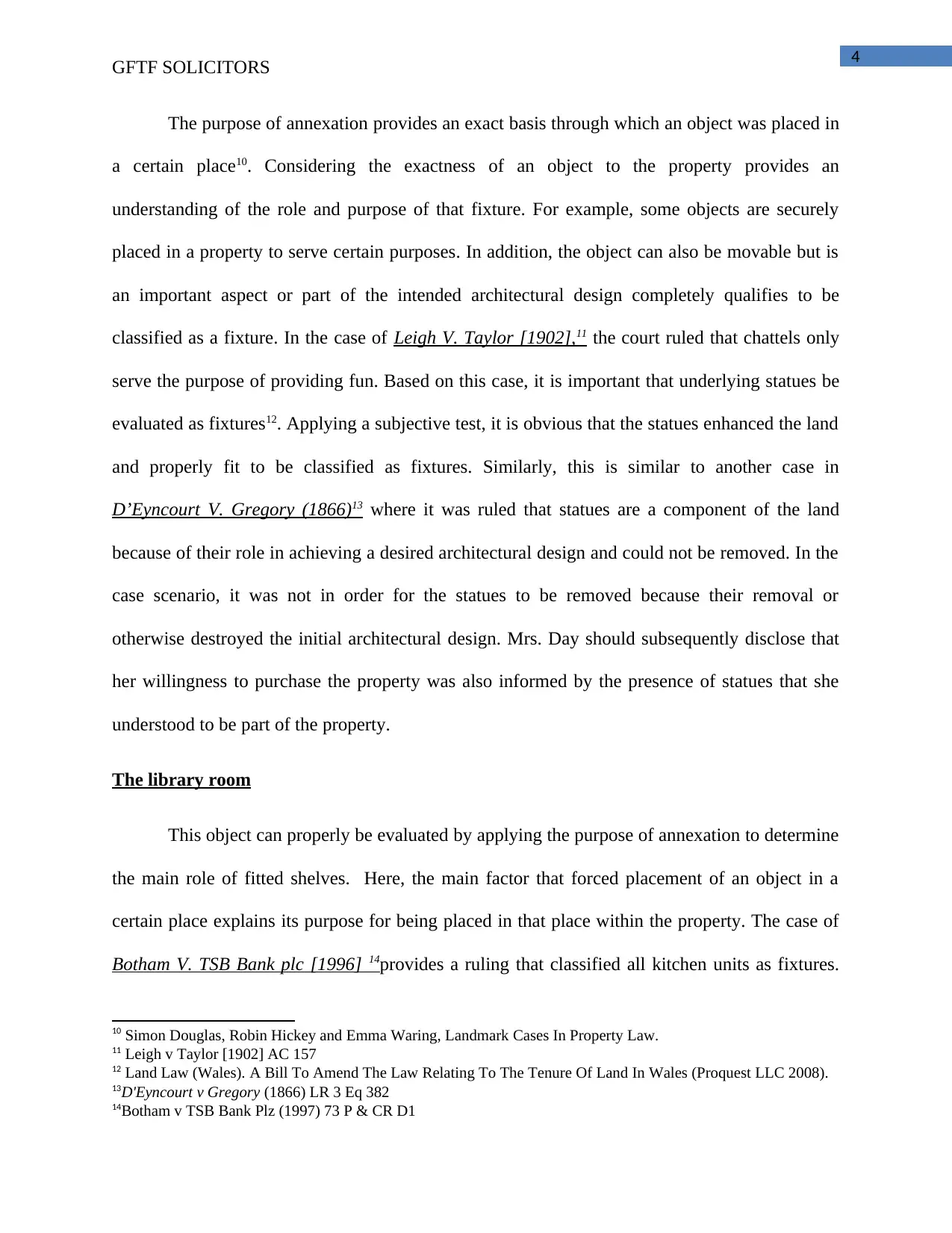
4
GFTF SOLICITORS
The purpose of annexation provides an exact basis through which an object was placed in
a certain place10. Considering the exactness of an object to the property provides an
understanding of the role and purpose of that fixture. For example, some objects are securely
placed in a property to serve certain purposes. In addition, the object can also be movable but is
an important aspect or part of the intended architectural design completely qualifies to be
classified as a fixture. In the case of Leigh V. Taylor [1902],11 the court ruled that chattels only
serve the purpose of providing fun. Based on this case, it is important that underlying statues be
evaluated as fixtures12. Applying a subjective test, it is obvious that the statues enhanced the land
and properly fit to be classified as fixtures. Similarly, this is similar to another case in
D’Eyncourt V. Gregory (1866)13 where it was ruled that statues are a component of the land
because of their role in achieving a desired architectural design and could not be removed. In the
case scenario, it was not in order for the statues to be removed because their removal or
otherwise destroyed the initial architectural design. Mrs. Day should subsequently disclose that
her willingness to purchase the property was also informed by the presence of statues that she
understood to be part of the property.
The library room
This object can properly be evaluated by applying the purpose of annexation to determine
the main role of fitted shelves. Here, the main factor that forced placement of an object in a
certain place explains its purpose for being placed in that place within the property. The case of
Botham V. TSB Bank plc [1996] 14provides a ruling that classified all kitchen units as fixtures.
10 Simon Douglas, Robin Hickey and Emma Waring, Landmark Cases In Property Law.
11 Leigh v Taylor [1902] AC 157
12 Land Law (Wales). A Bill To Amend The Law Relating To The Tenure Of Land In Wales (Proquest LLC 2008).
13D'Eyncourt v Gregory (1866) LR 3 Eq 382
14Botham v TSB Bank Plz (1997) 73 P & CR D1
GFTF SOLICITORS
The purpose of annexation provides an exact basis through which an object was placed in
a certain place10. Considering the exactness of an object to the property provides an
understanding of the role and purpose of that fixture. For example, some objects are securely
placed in a property to serve certain purposes. In addition, the object can also be movable but is
an important aspect or part of the intended architectural design completely qualifies to be
classified as a fixture. In the case of Leigh V. Taylor [1902],11 the court ruled that chattels only
serve the purpose of providing fun. Based on this case, it is important that underlying statues be
evaluated as fixtures12. Applying a subjective test, it is obvious that the statues enhanced the land
and properly fit to be classified as fixtures. Similarly, this is similar to another case in
D’Eyncourt V. Gregory (1866)13 where it was ruled that statues are a component of the land
because of their role in achieving a desired architectural design and could not be removed. In the
case scenario, it was not in order for the statues to be removed because their removal or
otherwise destroyed the initial architectural design. Mrs. Day should subsequently disclose that
her willingness to purchase the property was also informed by the presence of statues that she
understood to be part of the property.
The library room
This object can properly be evaluated by applying the purpose of annexation to determine
the main role of fitted shelves. Here, the main factor that forced placement of an object in a
certain place explains its purpose for being placed in that place within the property. The case of
Botham V. TSB Bank plc [1996] 14provides a ruling that classified all kitchen units as fixtures.
10 Simon Douglas, Robin Hickey and Emma Waring, Landmark Cases In Property Law.
11 Leigh v Taylor [1902] AC 157
12 Land Law (Wales). A Bill To Amend The Law Relating To The Tenure Of Land In Wales (Proquest LLC 2008).
13D'Eyncourt v Gregory (1866) LR 3 Eq 382
14Botham v TSB Bank Plz (1997) 73 P & CR D1
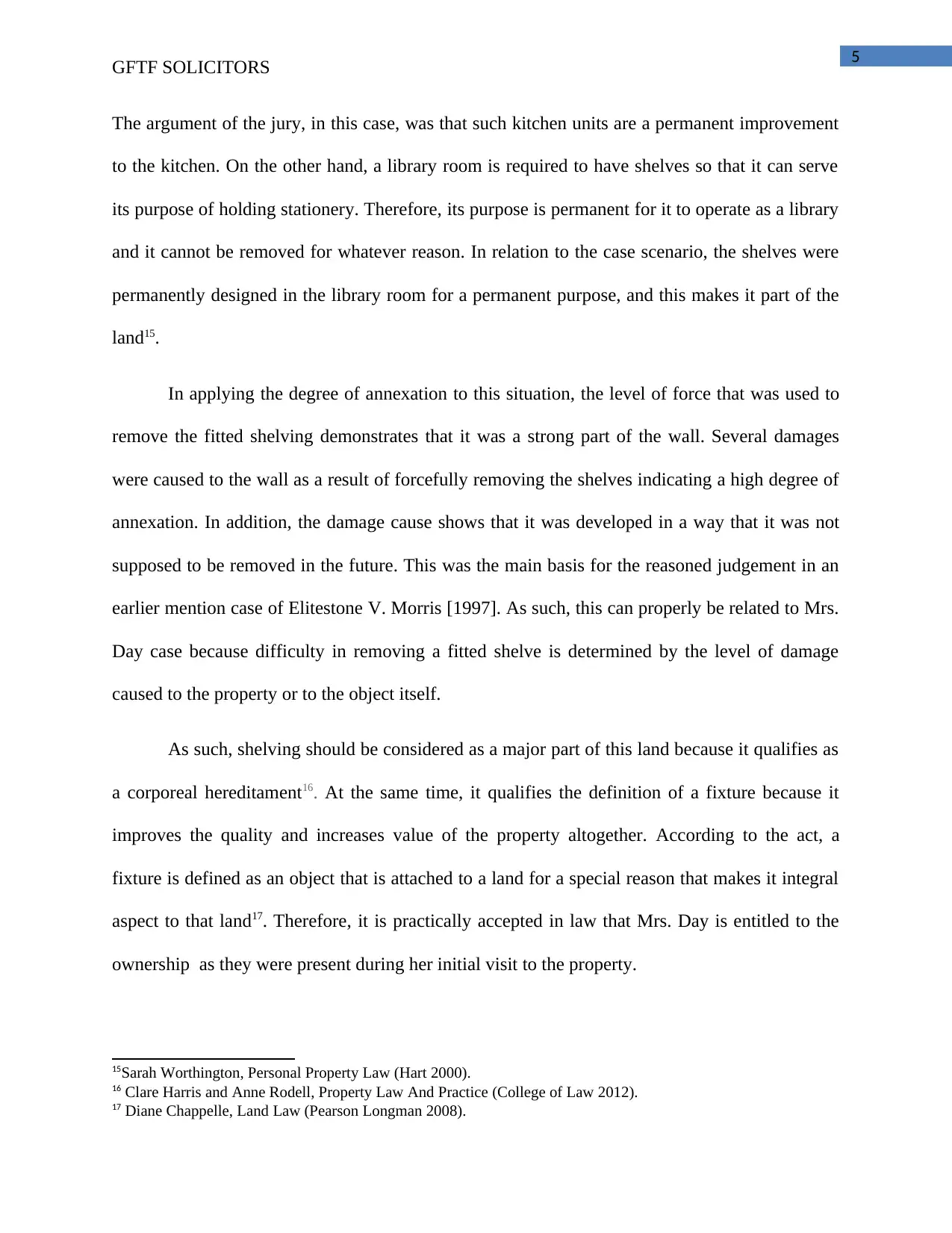
5
GFTF SOLICITORS
The argument of the jury, in this case, was that such kitchen units are a permanent improvement
to the kitchen. On the other hand, a library room is required to have shelves so that it can serve
its purpose of holding stationery. Therefore, its purpose is permanent for it to operate as a library
and it cannot be removed for whatever reason. In relation to the case scenario, the shelves were
permanently designed in the library room for a permanent purpose, and this makes it part of the
land15.
In applying the degree of annexation to this situation, the level of force that was used to
remove the fitted shelving demonstrates that it was a strong part of the wall. Several damages
were caused to the wall as a result of forcefully removing the shelves indicating a high degree of
annexation. In addition, the damage cause shows that it was developed in a way that it was not
supposed to be removed in the future. This was the main basis for the reasoned judgement in an
earlier mention case of Elitestone V. Morris [1997]. As such, this can properly be related to Mrs.
Day case because difficulty in removing a fitted shelve is determined by the level of damage
caused to the property or to the object itself.
As such, shelving should be considered as a major part of this land because it qualifies as
a corporeal hereditament16. At the same time, it qualifies the definition of a fixture because it
improves the quality and increases value of the property altogether. According to the act, a
fixture is defined as an object that is attached to a land for a special reason that makes it integral
aspect to that land17. Therefore, it is practically accepted in law that Mrs. Day is entitled to the
ownership as they were present during her initial visit to the property.
15Sarah Worthington, Personal Property Law (Hart 2000).
16 Clare Harris and Anne Rodell, Property Law And Practice (College of Law 2012).
17 Diane Chappelle, Land Law (Pearson Longman 2008).
GFTF SOLICITORS
The argument of the jury, in this case, was that such kitchen units are a permanent improvement
to the kitchen. On the other hand, a library room is required to have shelves so that it can serve
its purpose of holding stationery. Therefore, its purpose is permanent for it to operate as a library
and it cannot be removed for whatever reason. In relation to the case scenario, the shelves were
permanently designed in the library room for a permanent purpose, and this makes it part of the
land15.
In applying the degree of annexation to this situation, the level of force that was used to
remove the fitted shelving demonstrates that it was a strong part of the wall. Several damages
were caused to the wall as a result of forcefully removing the shelves indicating a high degree of
annexation. In addition, the damage cause shows that it was developed in a way that it was not
supposed to be removed in the future. This was the main basis for the reasoned judgement in an
earlier mention case of Elitestone V. Morris [1997]. As such, this can properly be related to Mrs.
Day case because difficulty in removing a fitted shelve is determined by the level of damage
caused to the property or to the object itself.
As such, shelving should be considered as a major part of this land because it qualifies as
a corporeal hereditament16. At the same time, it qualifies the definition of a fixture because it
improves the quality and increases value of the property altogether. According to the act, a
fixture is defined as an object that is attached to a land for a special reason that makes it integral
aspect to that land17. Therefore, it is practically accepted in law that Mrs. Day is entitled to the
ownership as they were present during her initial visit to the property.
15Sarah Worthington, Personal Property Law (Hart 2000).
16 Clare Harris and Anne Rodell, Property Law And Practice (College of Law 2012).
17 Diane Chappelle, Land Law (Pearson Longman 2008).
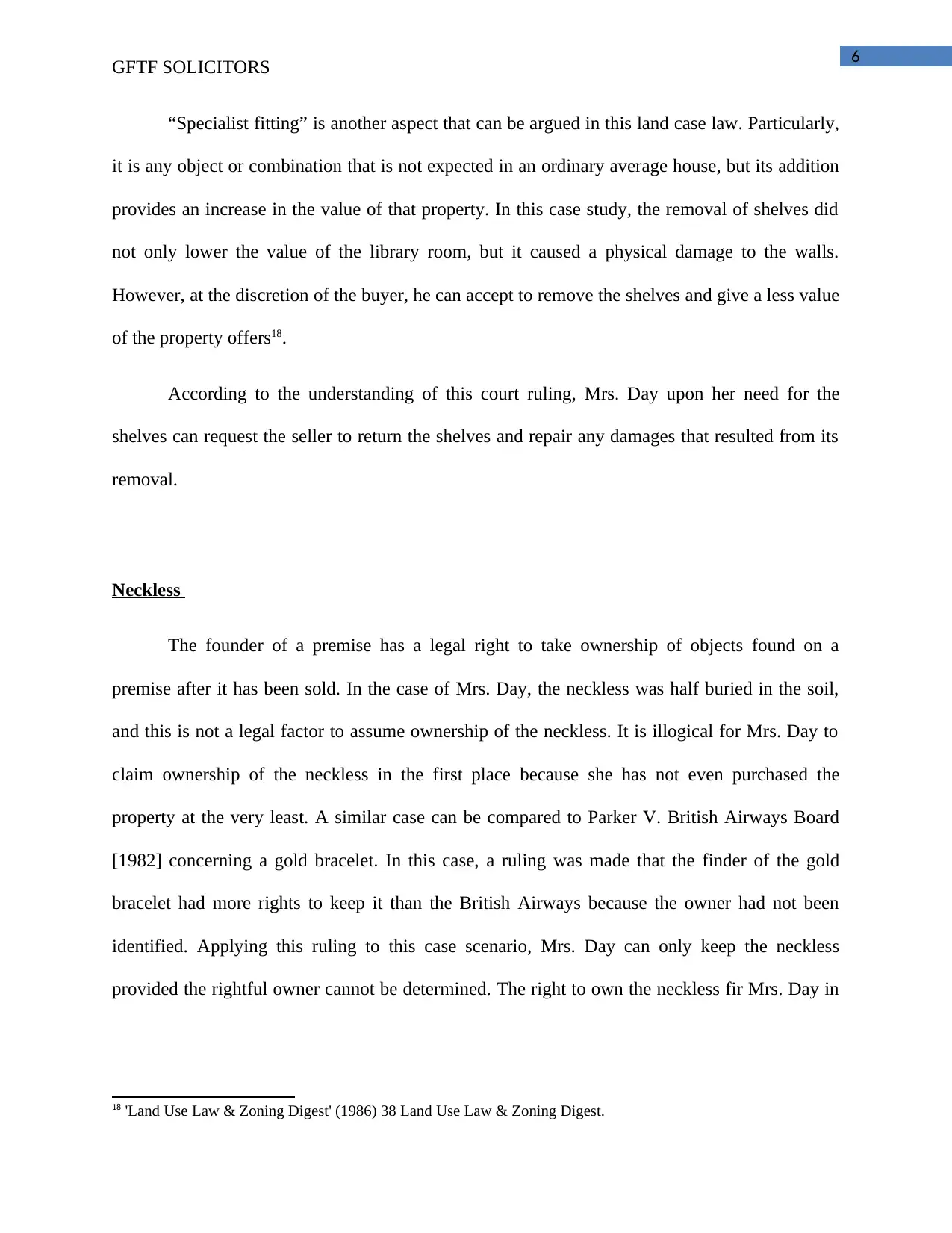
6
GFTF SOLICITORS
“Specialist fitting” is another aspect that can be argued in this land case law. Particularly,
it is any object or combination that is not expected in an ordinary average house, but its addition
provides an increase in the value of that property. In this case study, the removal of shelves did
not only lower the value of the library room, but it caused a physical damage to the walls.
However, at the discretion of the buyer, he can accept to remove the shelves and give a less value
of the property offers18.
According to the understanding of this court ruling, Mrs. Day upon her need for the
shelves can request the seller to return the shelves and repair any damages that resulted from its
removal.
Neckless
The founder of a premise has a legal right to take ownership of objects found on a
premise after it has been sold. In the case of Mrs. Day, the neckless was half buried in the soil,
and this is not a legal factor to assume ownership of the neckless. It is illogical for Mrs. Day to
claim ownership of the neckless in the first place because she has not even purchased the
property at the very least. A similar case can be compared to Parker V. British Airways Board
[1982] concerning a gold bracelet. In this case, a ruling was made that the finder of the gold
bracelet had more rights to keep it than the British Airways because the owner had not been
identified. Applying this ruling to this case scenario, Mrs. Day can only keep the neckless
provided the rightful owner cannot be determined. The right to own the neckless fir Mrs. Day in
18 'Land Use Law & Zoning Digest' (1986) 38 Land Use Law & Zoning Digest.
GFTF SOLICITORS
“Specialist fitting” is another aspect that can be argued in this land case law. Particularly,
it is any object or combination that is not expected in an ordinary average house, but its addition
provides an increase in the value of that property. In this case study, the removal of shelves did
not only lower the value of the library room, but it caused a physical damage to the walls.
However, at the discretion of the buyer, he can accept to remove the shelves and give a less value
of the property offers18.
According to the understanding of this court ruling, Mrs. Day upon her need for the
shelves can request the seller to return the shelves and repair any damages that resulted from its
removal.
Neckless
The founder of a premise has a legal right to take ownership of objects found on a
premise after it has been sold. In the case of Mrs. Day, the neckless was half buried in the soil,
and this is not a legal factor to assume ownership of the neckless. It is illogical for Mrs. Day to
claim ownership of the neckless in the first place because she has not even purchased the
property at the very least. A similar case can be compared to Parker V. British Airways Board
[1982] concerning a gold bracelet. In this case, a ruling was made that the finder of the gold
bracelet had more rights to keep it than the British Airways because the owner had not been
identified. Applying this ruling to this case scenario, Mrs. Day can only keep the neckless
provided the rightful owner cannot be determined. The right to own the neckless fir Mrs. Day in
18 'Land Use Law & Zoning Digest' (1986) 38 Land Use Law & Zoning Digest.
Paraphrase This Document
Need a fresh take? Get an instant paraphrase of this document with our AI Paraphraser

7
GFTF SOLICITORS
case of the absence of a claim from the owner is based on her proving ownership of the property
on which she found the neckless19.
A similar case Hannah V. Peel [1945], a court ruled that a soldier who obtained a brooch
had more rights of ownership than the landowner. The basis of the court decision was based on
the location in which the brooch was discovered. The case of Mrs. Day would be easy to decide
based on the above case similarity. However, the challenge comes in the manner it was obtained.
It was half buried in the soil, and this has a bearing on the decision. Mrs. Day has a role and legal
burden of proof to demonstrate that the neckless was not attached or located beneath the surface
of the land. In the event that she cannot prove these issues, it is obvious that the landowner has a
more right to the neckless and it would illegal for the finder to stay with the jewellery. Another
possible recommendation can be based on the case of Bridges V. Hawksworth [1851] concerning
bank notes. In the ruling of this case, a claimant was awarded the ownership of bank notes after
he had surrendered them. After three years there was no real owner of the bank notes, and the
court ruled that it should be given to the claimant. Applying this ruling to the case scenario, Mrs.
Day can surrender the neckless under the condition that it should be returned in case the real
owner is not established.
19 Robert Megarry and others, The Law Of Real Property (Sweet & Maxwell 2012).
GFTF SOLICITORS
case of the absence of a claim from the owner is based on her proving ownership of the property
on which she found the neckless19.
A similar case Hannah V. Peel [1945], a court ruled that a soldier who obtained a brooch
had more rights of ownership than the landowner. The basis of the court decision was based on
the location in which the brooch was discovered. The case of Mrs. Day would be easy to decide
based on the above case similarity. However, the challenge comes in the manner it was obtained.
It was half buried in the soil, and this has a bearing on the decision. Mrs. Day has a role and legal
burden of proof to demonstrate that the neckless was not attached or located beneath the surface
of the land. In the event that she cannot prove these issues, it is obvious that the landowner has a
more right to the neckless and it would illegal for the finder to stay with the jewellery. Another
possible recommendation can be based on the case of Bridges V. Hawksworth [1851] concerning
bank notes. In the ruling of this case, a claimant was awarded the ownership of bank notes after
he had surrendered them. After three years there was no real owner of the bank notes, and the
court ruled that it should be given to the claimant. Applying this ruling to the case scenario, Mrs.
Day can surrender the neckless under the condition that it should be returned in case the real
owner is not established.
19 Robert Megarry and others, The Law Of Real Property (Sweet & Maxwell 2012).
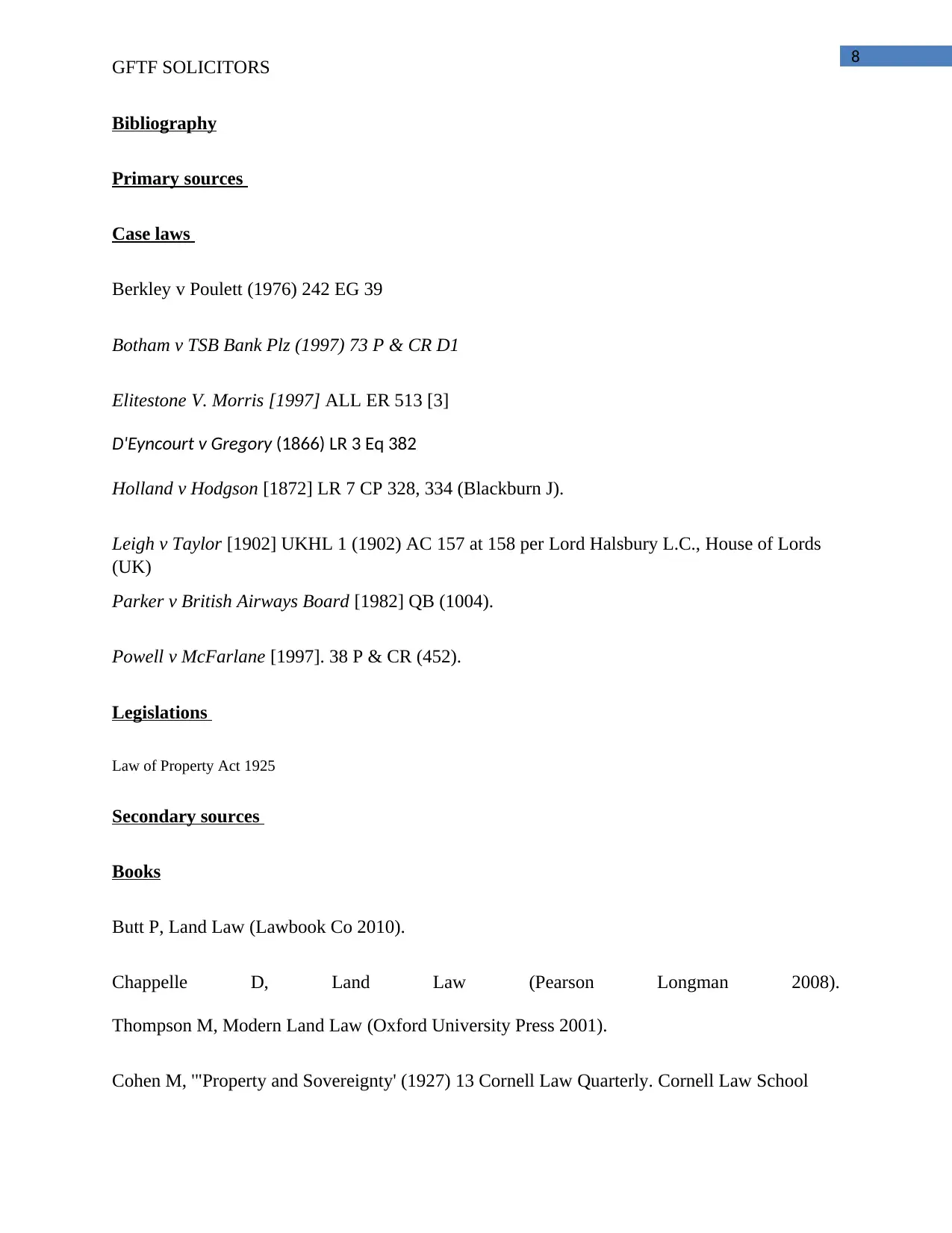
8
GFTF SOLICITORS
Bibliography
Primary sources
Case laws
Berkley v Poulett (1976) 242 EG 39
Botham v TSB Bank Plz (1997) 73 P & CR D1
Elitestone V. Morris [1997] ALL ER 513 [3]
D'Eyncourt v Gregory (1866) LR 3 Eq 382
Holland v Hodgson [1872] LR 7 CP 328, 334 (Blackburn J).
Leigh v Taylor [1902] UKHL 1 (1902) AC 157 at 158 per Lord Halsbury L.C., House of Lords
(UK)
Parker v British Airways Board [1982] QB (1004).
Powell v McFarlane [1997]. 38 P & CR (452).
Legislations
Law of Property Act 1925
Secondary sources
Books
Butt P, Land Law (Lawbook Co 2010).
Chappelle D, Land Law (Pearson Longman 2008).
Thompson M, Modern Land Law (Oxford University Press 2001).
Cohen M, '"Property and Sovereignty' (1927) 13 Cornell Law Quarterly. Cornell Law School
GFTF SOLICITORS
Bibliography
Primary sources
Case laws
Berkley v Poulett (1976) 242 EG 39
Botham v TSB Bank Plz (1997) 73 P & CR D1
Elitestone V. Morris [1997] ALL ER 513 [3]
D'Eyncourt v Gregory (1866) LR 3 Eq 382
Holland v Hodgson [1872] LR 7 CP 328, 334 (Blackburn J).
Leigh v Taylor [1902] UKHL 1 (1902) AC 157 at 158 per Lord Halsbury L.C., House of Lords
(UK)
Parker v British Airways Board [1982] QB (1004).
Powell v McFarlane [1997]. 38 P & CR (452).
Legislations
Law of Property Act 1925
Secondary sources
Books
Butt P, Land Law (Lawbook Co 2010).
Chappelle D, Land Law (Pearson Longman 2008).
Thompson M, Modern Land Law (Oxford University Press 2001).
Cohen M, '"Property and Sovereignty' (1927) 13 Cornell Law Quarterly. Cornell Law School
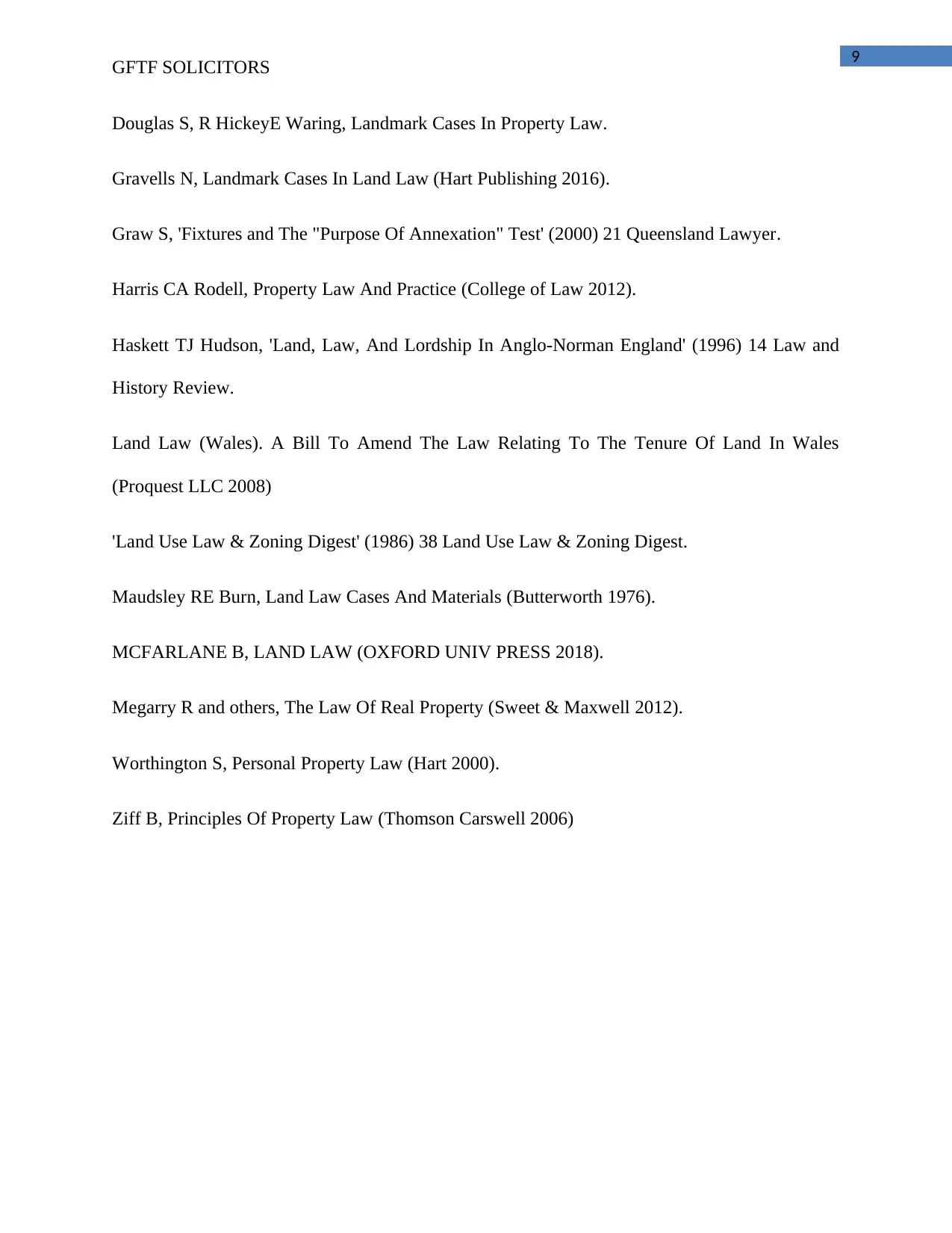
9
GFTF SOLICITORS
Douglas S, R HickeyE Waring, Landmark Cases In Property Law.
Gravells N, Landmark Cases In Land Law (Hart Publishing 2016).
Graw S, 'Fixtures and The "Purpose Of Annexation" Test' (2000) 21 Queensland Lawyer.
Harris CA Rodell, Property Law And Practice (College of Law 2012).
Haskett TJ Hudson, 'Land, Law, And Lordship In Anglo-Norman England' (1996) 14 Law and
History Review.
Land Law (Wales). A Bill To Amend The Law Relating To The Tenure Of Land In Wales
(Proquest LLC 2008)
'Land Use Law & Zoning Digest' (1986) 38 Land Use Law & Zoning Digest.
Maudsley RE Burn, Land Law Cases And Materials (Butterworth 1976).
MCFARLANE B, LAND LAW (OXFORD UNIV PRESS 2018).
Megarry R and others, The Law Of Real Property (Sweet & Maxwell 2012).
Worthington S, Personal Property Law (Hart 2000).
Ziff B, Principles Of Property Law (Thomson Carswell 2006)
GFTF SOLICITORS
Douglas S, R HickeyE Waring, Landmark Cases In Property Law.
Gravells N, Landmark Cases In Land Law (Hart Publishing 2016).
Graw S, 'Fixtures and The "Purpose Of Annexation" Test' (2000) 21 Queensland Lawyer.
Harris CA Rodell, Property Law And Practice (College of Law 2012).
Haskett TJ Hudson, 'Land, Law, And Lordship In Anglo-Norman England' (1996) 14 Law and
History Review.
Land Law (Wales). A Bill To Amend The Law Relating To The Tenure Of Land In Wales
(Proquest LLC 2008)
'Land Use Law & Zoning Digest' (1986) 38 Land Use Law & Zoning Digest.
Maudsley RE Burn, Land Law Cases And Materials (Butterworth 1976).
MCFARLANE B, LAND LAW (OXFORD UNIV PRESS 2018).
Megarry R and others, The Law Of Real Property (Sweet & Maxwell 2012).
Worthington S, Personal Property Law (Hart 2000).
Ziff B, Principles Of Property Law (Thomson Carswell 2006)
1 out of 10
Your All-in-One AI-Powered Toolkit for Academic Success.
+13062052269
info@desklib.com
Available 24*7 on WhatsApp / Email
![[object Object]](/_next/static/media/star-bottom.7253800d.svg)
Unlock your academic potential
© 2024 | Zucol Services PVT LTD | All rights reserved.

